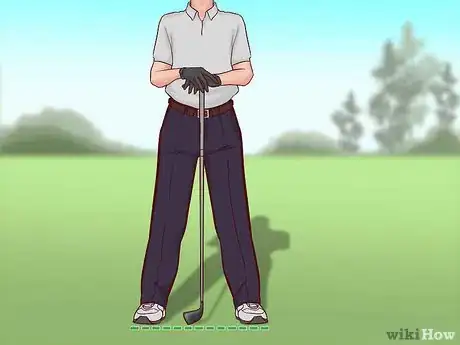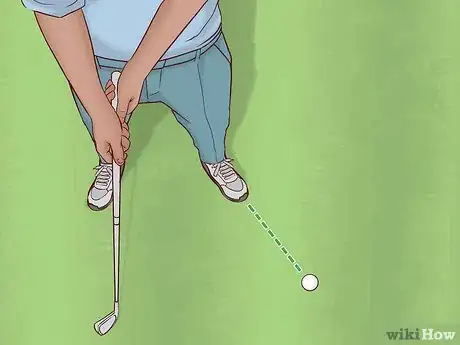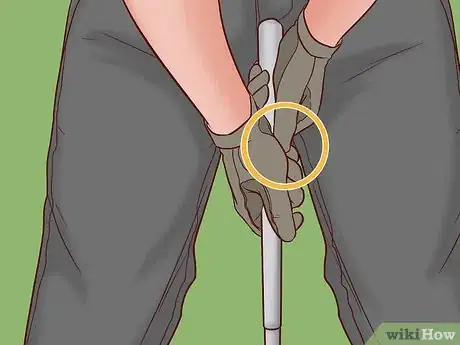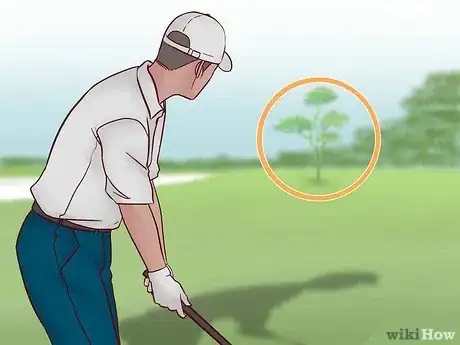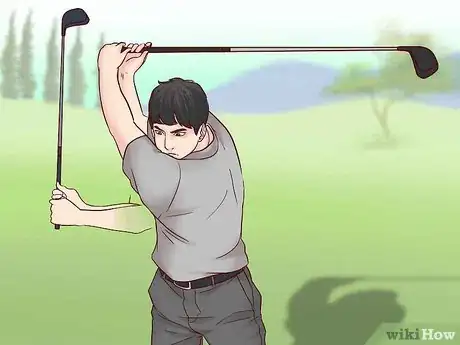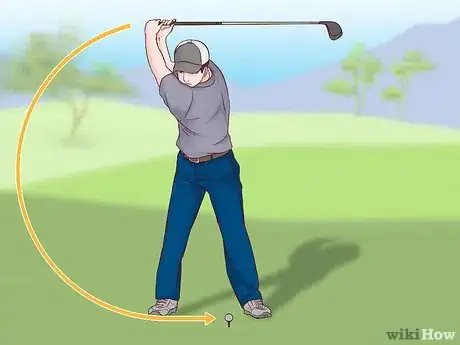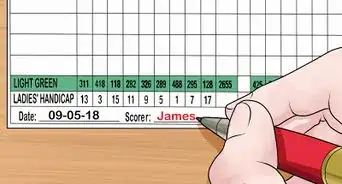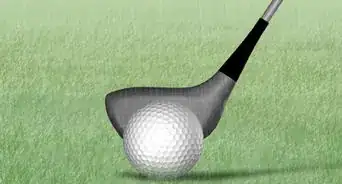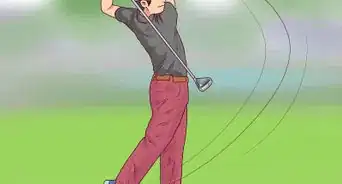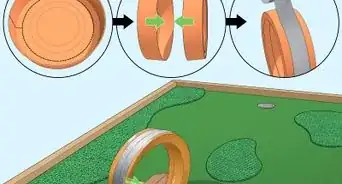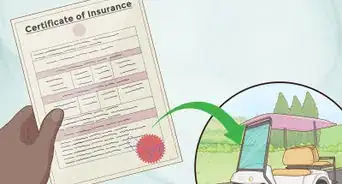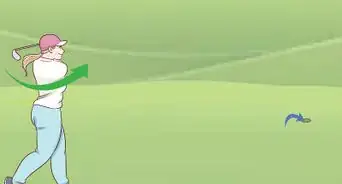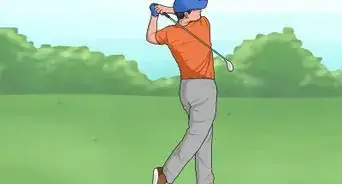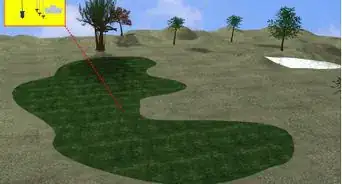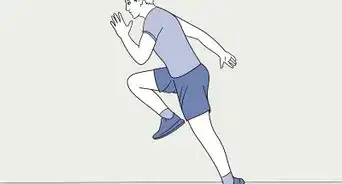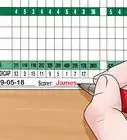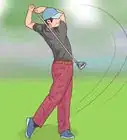This article was co-authored by Michael Metz. Michael Metz is a Golf Instructor and the Director of Instruction at Simi Hills Golf Course. With more than 15 years of experience, Michael is adept at coaching all facets of Golf. Mike uses technology, such as Flightscope, V1 Swing Suite, Blast Motion, and BodiTrak pressure mapping, to provide advanced golf training with quick results.
This article has been viewed 85,387 times.
Driving can be the most intimidating part of golfing for beginners. It's the first shot on any hole, so it's important to get it right! Make sure to position yourself and the ball correctly, then use proper balance and technique as you swing to hit the ball. Avoid typical mistakes that beginners make, like trying to hit the ball with all your strength, and with a little practice you'll be sending drives straight and far down the fairway in no time!
Things You Should Know
- First, you'll want to get into position with a wide stance, proper foot and arm placement, and the tee high off of the green.
- Then, you'll need to find your aim to line up your stance, loosen up your body, and prepare for your swing.
- Finally, perform your upswing, pause for just a fraction of a second with your driver over your head, and then, perform your downswing.
Steps
Getting into Position
-
1Set your stance wider than your shoulders. Stand straight with your feet out slightly wider than your shoulders. A wide stance will allow you to have a longer swing when you drive.[1]
- In general, longer clubs need wider stances, while shorter clubs need narrower stances. For example, you would use a very narrow stance for a short wedge club.
-
2Line the ball up with the inside of your dominant foot in front of you. Many beginners tend to place the ball exactly in the middle. You need to set the ball more forward in your stance, since the driver is a long club, to allow the driver to square up with it.[2]
- This also means that the driver will hit the ball on the upswing, which creates less spin and straighter drives.
Advertisement -
3Grip the club like a baseball bat with your dominant hand in front. Place both your hands on the grip of the driver, the same way you would hold a baseball bat, but with the club angled down towards the ball.[3] Point the butt end of the club at your belt buckle (or where it would be).[4]
- You can try interlocking the little finger of your dominant hand with the index finger of your non-dominant hand. This can add comfort and stability to your swing.
-
4Hold the driver 10–12 inches (25–30 cm) away from your body. Hold the handle of the club so that the butt end is about 10–12 inches (25–30 cm) away from your belt buckle. Back away from the ball until you create enough space to hold the driver at this distance.[5]
- Having your hands too close to your body will create a poor swing during the first part of the swing.
-
5Tee the ball up high with a 2.75 inches (7.0 cm) tee. Use a standard 2.75 inches (7.0 cm) tee and barely stick it in the ground. This allows you to hit more of the ball on the upswing and send it further and straighter.[6]
- As you get more experienced, you can adjust the height that you tee the ball at to suit your style and preference.
Swinging the Club
-
1Pick a target in the distance to aim for. Choose a tree or a far away bunker, instead of just looking down the green. Stare at your target and use it to line up your stance to get ready to begin your swing.[7]
- As a beginner, it's easy to make the mistake of just aiming down the fairway and swinging away with all you've got, instead of picking a target to focus on.[8]
-
2Waggle the club back and forth to loosen up before you start your backswing. Don't lock up tight or you will have a poor swing. Waggle the club until you feel your fingers and feet loosen up.[9]
- Lots of beginners freeze up under the pressure of driving. It is critical to keep your body relaxed to drive well.
-
3Stay balanced, go slow, and spend time at the top of your backswing. Keep your center of gravity in the middle as you start your backswing. Slowly pull the driver back and up above your head. Pause at the top of your backswing for just a fraction of a second before you bring it back down towards the ball.[10]
- Many beginners make the mistake of letting their center of gravity shift to the back, which will take away accuracy and power when you drive.
- The “pause” at the top is really just a slight hesitation that will allow your body to adjust and align the driver for the downswing. Many beginners don't let the club reach the top all the way on their backswing, which takes away power and accuracy from the swing as well.
- It's a common misconception among beginners that you must pull the driver back and swing as fast as possible, when in fact, the opposite is true. Focus on your form during the backswing and pull the club back slowly.
-
4Use a sweeping motion and shift your balance forward during the downswing. Bring the driver back down at the ball and shift your center of gravity to your front foot as you make contact. Use a sweeping motion, instead of a downward angle, to give the ball more lift and less spin.[11]
- Remember that you don't need to hit the ball at full force to send it far. Driving is more about form, balance, and technique than power.
-
5Swing through the ball and maintain your arm speed after you hit it.[12] Let your arms keep swinging in a sweeping motion even after you make contact with the ball. This will create a smooth swing tempo and give your drive more accuracy.[13]
- As a beginner, you may be tempted to just hit the ball hard, and then forcefully stop your swing, but remember to allow your arms and body to fully complete the swing. You should end with the driver above your head again in front of you.
Expert Q&A
-
QuestionWhy is it so hard to swing a driver?
 Michael MetzMichael Metz is a Golf Instructor and the Director of Instruction at Simi Hills Golf Course. With more than 15 years of experience, Michael is adept at coaching all facets of Golf. Mike uses technology, such as Flightscope, V1 Swing Suite, Blast Motion, and BodiTrak pressure mapping, to provide advanced golf training with quick results.
Michael MetzMichael Metz is a Golf Instructor and the Director of Instruction at Simi Hills Golf Course. With more than 15 years of experience, Michael is adept at coaching all facets of Golf. Mike uses technology, such as Flightscope, V1 Swing Suite, Blast Motion, and BodiTrak pressure mapping, to provide advanced golf training with quick results.
Golf Instructor Some people don't focus enough on the speed of their swing. You can have a great-looking swing that doesn't have much speed, but then it's very difficult to teach speed after you have the fundamentals. So, it's always better to learn how to swing fast first, and then place the body where it needs to be according to the speed after that.
Some people don't focus enough on the speed of their swing. You can have a great-looking swing that doesn't have much speed, but then it's very difficult to teach speed after you have the fundamentals. So, it's always better to learn how to swing fast first, and then place the body where it needs to be according to the speed after that.
References
- ↑ https://golf-info-guide.com/golf-tips/beginner-golf-tips/top-5-tips-on-beginner-golf-driving/
- ↑ https://golf-info-guide.com/golf-tips/beginner-golf-tips/top-5-tips-on-beginner-golf-driving/
- ↑ Michael Metz. Golf Instructor. Expert Interview. 24 March 2022.
- ↑ https://golf-info-guide.com/golf-tips/beginner-golf-tips/top-5-tips-on-beginner-golf-driving/
- ↑ https://golf-info-guide.com/golf-tips/beginner-golf-tips/top-5-tips-on-beginner-golf-driving/
- ↑ https://golf-info-guide.com/golf-tips/beginner-golf-tips/top-5-tips-on-beginner-golf-driving/
- ↑ https://golftips.golfweek.com/directions-hitting-golf-driver-2465.html
- ↑ Michael Metz. Golf Instructor. Expert Interview. 24 March 2022.
- ↑ https://www.golfdigest.com/story/butch-harmon-best-driving-tips
- ↑ https://golftips.golfweek.com/directions-hitting-golf-driver-2465.html
- ↑ https://golftips.golfweek.com/directions-hitting-golf-driver-2465.html
- ↑ Michael Metz. Golf Instructor. Expert Interview. 24 March 2022.
- ↑ https://www.golfdigest.com/story/butch-harmon-best-driving-tips
